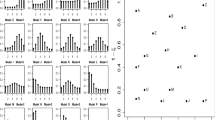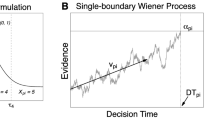Abstract
This paper considers the methodological challenge of how to convert categorical attitudinal scores (like satisfaction) measured on one scale to a categorical attitudinal score measured on another scale with a different range. This is becoming a growing issue in marketing consulting and the common available solutions seem too few and too superficial. A new methodology for scale conversion is proposed, and tested in a comprehensive study. This methodology is shown to be both relevant and optimal in fundamental aspects. The new methodology is based on a novel algorithm named minimum conditional entropy, that uses the marginal distributions of the responses on each of the two scales to produce a unique joint bivariate distribution. In this joint distribution, the conditional distributions follow a stochastic order that is monotone in the categories and has the relevant optimal property of maximizing the correlation between the two underlying marginal scales. We show how such a joint distribution can be used to build a mechanism for scale conversion. We use both a frequentist and a Bayesian approach to derive mixture models for conversion mechanisms, and discuss some inferential aspects associated with the underlying models. These models can incorporate background variables of the respondents. A unique observational experiment is conducted that empirically validates the proposed modeling approach. Strong evidence of validation is obtained.























Similar content being viewed by others
References
Accioly, R., & Chiyoshi, F. (2004). Modeling dependence with copulas: A useful tool for field development decision process. Journal of Petroleum Science and Engineering, 44, 8391.
Chang, L. (1994). A psychometric evaluation of 4-point and 6-point Likert-type scales in relation to reliability and validity. Applied Psychological Measurement, 18(3), 205–215.
Churchill, G. A., Jr., & Peter, J. P. (1984). Research design effects on the reliability of rating scales: A meta-analysis. Journal of Marketing Research, 360–375.
Colman, A. M., Morris, C. E., & Preston, C. C. (1997). Comparing rating scales of different lengths: Equivalence of scores from 5-point and 7-point scales. Psychological Reports, 80(2), 355–362.
Cox, E. P., III. (1980). The optimal number of response alternatives for a scale: A review. Journal of Marketing Research, 407–422.
DallAglio, G., & Bona, E. (2011). The minimum of the entropy of a two-dimensional distribution with given marginals. Electronic Journal of Statistics. April, 1–14.
Dawes, J. G. (2008). Do data characteristics change according to the number of scale points used? An experiment using 5 point, 7 point and 10 point scales. International Journal of Market Research, 51(1).
Dolnicar, S., & Gr un, B. (2013). Translating between survey answer formats. Journal of Business Research, 66(9), 1298–1306.
Elidan, G. (2010). Copula bayesian networks. In J. Lafferty, C. K. I. Williams, J. ShaweTaylor, R. Zemel, & A. Culotta (Eds.), Advances in neural information processing systems 23 (pp. 559567). Red hook. New York: Curran Associates.
Evans, M., Gilula, Z., & Guttman, I. (2012). Conversion of ordinal attitudinal scales: An inferential Bayesian approach. Quantitative Marketing and Economics, 10(3), 283–304.
Gilula, Z., Kriger, A. M., & Ritov, Y. (1988). Ordinal Association in Contingency Tables: Some interpretive aspects. Journal of the American Statistical Association., 83(402), 540–545.
Gilula, Z., & Haberman, S. J. (1995). Dispersion of categorical variables and penalty functions: Derivation, estimation, and comparability. Journal of the American Statistical Association., 80, 1438–1446.
Gilula, Z., & McCulloch, R. (2013). Multilevel categorical data fusion using partially fused data. Quantitative Marketing and Economics, 11(3), 353–377.
Green, P. E., & Rao, V. R. (1970). Rating scales and information recovery-how many scales and responses categories to use? Journal of Marketing, 34, 33–39.
Kullback, S., & Leibler, R. A. (1951). On information and sufficiency, annals of. Mathematical Statistics, 2, 7986.
Miller, G. A. (1956). The magical number of seven, plus or minus two: Some limits on our capacity for processing information. Psychological Review, 63, 81–97.
Preston, C. C., & Colman, A. M. (2000). Optimal number of response categories in rating scales: Reliability, validity, discriminating power, and respondent preferences. Acta Psychologica, 104, 1–15.
Revilla, M. A., Saris, W. E., & Krosnick, J. A. (2014). Choosing the number of categories in agreedisagree scales. Sociological Methods & Research, 0049124113509605.
Taylor, A. B., West, S. G., & Aiken, L. S. (2006). Loss of power in logistic, ordinal logistic, and probit regression when an outcome variable is coarsely categorized. Educational and Psychological Measurement, 66(2), 228–239.
Author information
Authors and Affiliations
Corresponding author
Additional information
Publisher’s Note
Springer Nature remains neutral with regard to jurisdictional claims in published maps and institutional affiliations.
Appendices
Appendix 1
1.1 Data tables
Two way data tables for the question "How satisfied or dissatisfied are you with the quality of life in your city of residence?"
Appendix 2
1.1 Inferential aspects of the MCE algorithm
The MCE algorithm can be considered as the function Q = Ψ(P, P'), where P = (P1+, … , PR+), P' = (P'+1, … , P'+C) are probability vectors and Qij, i = 1, … , R, j = 1, … , C is a contingency vector with marginals P and P′. In practice it is used with sampled value, \( \widehat{Q}=\varPsi \left(\widehat{P},{\widehat{P}}^{\prime}\right) \), where \( \widehat{P} \) and \( {\widehat{P}}^{\hbox{'}} \) are estimators based on a sample.
We want to construct confidence intervals for the estimators \( \widehat{Q} \).
Let \( {\mathbb{P}}_i={\sum}_{k=1}^i{P}_{k+} \) the cumulative distribution function corresponding to P. Define similarly other cdf’s (e.g., ℙ' and  ), and \( {\mathbb{Q}}_{ij}={\sum}_{k=1}^i{\sum}_{l=1}^j{Q}_{kl} \). The CME algorithm is simply
), and \( {\mathbb{Q}}_{ij}={\sum}_{k=1}^i{\sum}_{l=1}^j{Q}_{kl} \). The CME algorithm is simply
We consider a standard fix point asymptotics. We assume.
A1. \( \widehat{P} \), \( {\widehat{P}}^{\hbox{'}} \) are independent and based on a multinomial samples with sizes n,n’ respectively.
A2. For all i = 1, …, R and j = 1, …, C, if ℙi = ℙ'j then i = R and j = C.
In that case the asymptotics is simple, since if ℙi < ℙ'j then ℚij = ℙi, and the CI of ℙi is the CI of ℚij as well.
As for Qij itself,
where ℚ0, j ≡ ℚi, 0 ≡ 0. Hence
where ℙ0 = ℙ'0 = 0. Without loss of generality, there are three possibilities:
- i.
Suppose ℙi < ℙ'j − 1. Then clearly ℙi − 1 < ℙi < ℙ'j − 1 < ℙ'j and hence Qij = 0. Thus \( {P}_r\left({\widehat{Q}}_{ij}={Q}_{ij}\right)\overset{\mathrm{p}}{\to }1 \).
- ii.
Suppose ℙi − 1 < ℙ'j − 1 < ℙ'j < ℙi. In this case Qij = ℙ'j − ℙ'j − 1 = ℙ'+j, and an asymptotic 1 − αconfidence interval for Qij is given by \( {\widehat{Q}}_{ij}\pm {z}_{\alpha /2}{n}^{\prime -1/2}\widehat{P}{\prime}_{+j}\left(1-\widehat{P}{\prime}_{+j}\right) \).
- iii.
Suppose ℙi − 1 < ℙ'j − 1 < ℙi < ℙ'j. In this case Qij = ℙi − ℙ'j − 1, and an asymptotic 1 − α confidence interval for Qij is given by
$$ {\widehat{Q}}_{ij}\pm {z}_{\alpha /2}{\left(\frac{{\widehat{P}}_{i+}\left(1-{\widehat{P}}_{i+}\right)}{n}+\frac{\widehat{P}{\hbox{'}}_{j-1,+}\left(1-\widehat{P}{\hbox{'}}_{j-1,+}\right)}{n^{\hbox{'}}}\right)}^{1/2}. $$
Rights and permissions
About this article
Cite this article
Gilula, Z., McCulloch, R.E., Ritov, Y. et al. A study into mechanisms of attitudinal scale conversion: A randomized stochastic ordering approach. Quant Mark Econ 17, 325–357 (2019). https://doi.org/10.1007/s11129-019-09209-3
Received:
Accepted:
Published:
Issue Date:
DOI: https://doi.org/10.1007/s11129-019-09209-3









